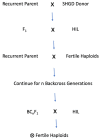Impact of Spontaneous Haploid Genome Doubling in Maize Breeding
- PMID: 32192066
- PMCID: PMC7154852
- DOI: 10.3390/plants9030369
Impact of Spontaneous Haploid Genome Doubling in Maize Breeding
Abstract
Doubled haploid (DH) technology has changed the maize-breeding landscape in recent years. Traditionally, DH production requires the use of chemical doubling agents to induce haploid genome doubling and, subsequently, male fertility. These chemicals can be harmful to humans and the plants themselves, and typically result in a doubling rate of 10%-30%. Spontaneous genome doubling and male fertility of maize haploids, without using chemical doubling agents, have been observed to a limited extent, for nearly 70 years. Rates of spontaneous haploid genome doubling (SHGD) have ranged from less than 5% to greater than 50%. Recently, there has been increased interest to forgo chemical treatment and instead utilize this natural method of doubling. Genetic-mapping studies comprising worldwide germplasm have been conducted. Of particular interest has been the detection of large-effect quantitative trait loci (QTL) affecting SHGD. Having a single large-effect QTL with an additive nature provides flexibility for the method of introgression, such as marker-assisted backcrossing, marker-assisted gene pyramiding, and systematic design. Moreover, it allows implementation of new methodologies, such as haploid-inducer mediated genome editing (HI-edit) and promotion of alleles by genome editing. We believe the use of SHGD can further enhance the impact of DH technology in maize.
Keywords: chemical doubling agent; colchicine; doubled haploid; genome doubling; haploid male fertility; maize; spontaneous haploid genome doubling.
Conflict of interest statement
The authors declare there are no conflicts of interest regarding the current work.
Figures




Similar articles
-
Genome-wide association study of haploid female fertility (HFF) and haploid male fertility (HMF) in BS39-derived doubled haploid maize lines.Theor Appl Genet. 2024 Dec 11;138(1):5. doi: 10.1007/s00122-024-04789-5. Theor Appl Genet. 2024. PMID: 39663254 Review.
-
QTL mapping of spontaneous haploid genome doubling using genotyping-by-sequencing in maize (Zea mays L.).Theor Appl Genet. 2020 Jul;133(7):2131-2140. doi: 10.1007/s00122-020-03585-1. Epub 2020 Apr 13. Theor Appl Genet. 2020. PMID: 32285163
-
Mapping of QTL and identification of candidate genes conferring spontaneous haploid genome doubling in maize (Zea mays L.).Plant Sci. 2020 Apr;293:110337. doi: 10.1016/j.plantsci.2019.110337. Epub 2019 Nov 21. Plant Sci. 2020. PMID: 32081276
-
Major locus for spontaneous haploid genome doubling detected by a case-control GWAS in exotic maize germplasm.Theor Appl Genet. 2021 May;134(5):1423-1434. doi: 10.1007/s00122-021-03780-8. Epub 2021 Feb 5. Theor Appl Genet. 2021. PMID: 33543310
-
Maize In Planta Haploid Inducer Lines: A Cornerstone for Doubled Haploid Technology.Methods Mol Biol. 2021;2288:25-48. doi: 10.1007/978-1-0716-1335-1_2. Methods Mol Biol. 2021. PMID: 34270003 Review.
Cited by
-
Haploid male fertility is restored by parallel spindle genes in Arabidopsis thaliana.Nat Plants. 2023 Feb;9(2):214-218. doi: 10.1038/s41477-022-01332-6. Epub 2023 Jan 9. Nat Plants. 2023. PMID: 36624258
-
A novel in vivo genome editing doubled haploid system for Zea mays L.Nat Plants. 2024 Oct;10(10):1493-1501. doi: 10.1038/s41477-024-01795-9. Epub 2024 Sep 27. Nat Plants. 2024. PMID: 39333351
-
Fine mapping of major QTL qshgd1 for spontaneous haploid genome doubling in maize (Zea mays L.).Theor Appl Genet. 2024 May 3;137(5):117. doi: 10.1007/s00122-024-04615-y. Theor Appl Genet. 2024. PMID: 38700534
-
Use of simulation to optimize a sweet corn breeding program: implementing genomic selection and doubled haploid technology.G3 (Bethesda). 2024 Aug 7;14(8):jkae128. doi: 10.1093/g3journal/jkae128. G3 (Bethesda). 2024. PMID: 38869242 Free PMC article.
-
Genome-wide association study of haploid female fertility (HFF) and haploid male fertility (HMF) in BS39-derived doubled haploid maize lines.Theor Appl Genet. 2024 Dec 11;138(1):5. doi: 10.1007/s00122-024-04789-5. Theor Appl Genet. 2024. PMID: 39663254 Review.
References
-
- Blakeslee A.F., Avery A.G. Methods of inducing doubling of chromosomes in plants by treatment with colchicine. J. Hered. 1937;12:393–411. doi: 10.1093/oxfordjournals.jhered.a104294. - DOI
-
- Chase S.S. Production of homozygous diploids of maize from monoploids. Agronomia. 1952;44:263–267. doi: 10.2134/agronj1952.00021962004400050010x. - DOI
-
- Geiger H.H., Gordillo G.A. Doubled haploids in hybrid maize breeding. Maydica. 2009;54:485–499.
-
- Seitz G. The use of doubled haploids in corn breeding; Proceedings of the Forty First Annual ILLINOIS Corn Breeders’ School, Urbana-Champaign; Champaign, IL, USA. 7–8 March 2005; pp. 1–7.
Publication types
Grants and funding
LinkOut - more resources
Full Text Sources

